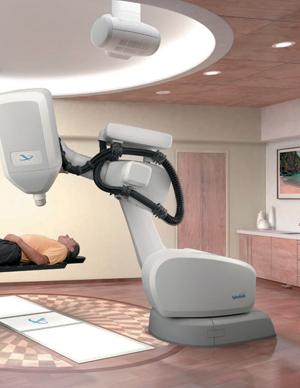
November 2, 2012 — A first-of-its-kind clinical trial conducted at University Hospitals (UH) Case Medical Center Seidman Cancer Center has shown encouraging results for the use of stereotactic radiosurgery to treat kidney cancer. This noninvasive treatment technique may represent a potential new nonsurgical option for patients with the disease who have limited treatment options.
Rod Ellis, M.D., lead author of the study along with principal investigator Lee Ponsky, M.D., presented results of a phase I clinical trial in 20 patients with localized primary renal cancer at the American Society for Radiation Oncology (ASTRO) annual meeting in Boston. In the abstract titled "Stereotactic Radiosurgery for Renal Cancer: Phase I Safety and Toxicity," Ellis presented data showing that 94 percent of patients treated in the study had decreased or stable disease, with limited side effects.
"This trial shows that low to moderate doses of stereotactic radiosurgery are safe for renal cancer patients who typically do not have surgical options," said Ellis, clinical director and vice chair for clinical affairs, department of radiation oncology at UH Case Medical Center, and associate professor of radiation oncology and urology at Case Western Reserve University School of Medicine. "Based on these findings, this treatment represents a promising therapeutic option. Further studies are needed to determine safe levels for the maximum dosage and by doing so, we hope to find increased response and cure rates with this method."
"This study is a unique partnership between a surgeon and radiation oncologist, intended to offer patients a noninvasive, highly focused ablative radiation with surgical precision with little to no side effects," said Ponsky, director of urologic oncology and minimally invasive therapies at UH Case Medial Center, and associate professor of urology at Case Western Reserve School of Medicine. "We are very excited about these results and cautiously optimistic about the future potential of this therapy."
According to the American Cancer Society, there are about 65,000 new cases of kidney cancer each year in the United States, and it is among the 10 most common cancers in both men and women. Treatment options typically include surgery or cryoablation (using cold therapy to destroy the tumor). However, many patients are not surgical candidates, and stereotactic radiosurgery provides a noninvasive alternative in just three treatments which requires no anesthesia or narcotics. Stereotactic radiosurgery is performed using Cyberknife, a robotic radiosurgery system which delivers targeted doses of radiation with submillimeter accuracy while minimizing damage to surrounding healthy tissue. This high-dose, focused radiation destroys tumor cells and stops cancer cells from growing.
This study followed patients from two to 41 months post-treatment using a four-part dose escalation schema. The response rate indicates that patients reacted well and had acceptable levels of treatment-related toxicity following stereotactic radiosurgery in all age groups from 58 to 92 years old.
Based on these positive results, Ellis, Ponsky and a team of researchers have launched a follow-up phase II study for 12 additional patients with increased dosage to determine the most effective dosage. "This study builds upon our team's previous work as we continue to evaluate and define the role of radiosurgery for the safe and effective treatment of kidney tumors," said Ponsky.
"Radiosurgery delivers a higher and more effective dose directly to the tumor site with less side effects than conventional radiation and has been very effective in treating other hard-to-reach tumors," said Ellis. "We are excited about its potential for kidney cancer patients and to be able to offer a noninvasive option."
Study co-authors include R.B. Patel, C. Kunos, Y. Zhang, J. Brindle, V. Kudithipudi and D.A. Kaminsky. The trial funded by Accuray Corp.
For more information: www.uhhospitals.org


 December 11, 2025
December 11, 2025 









